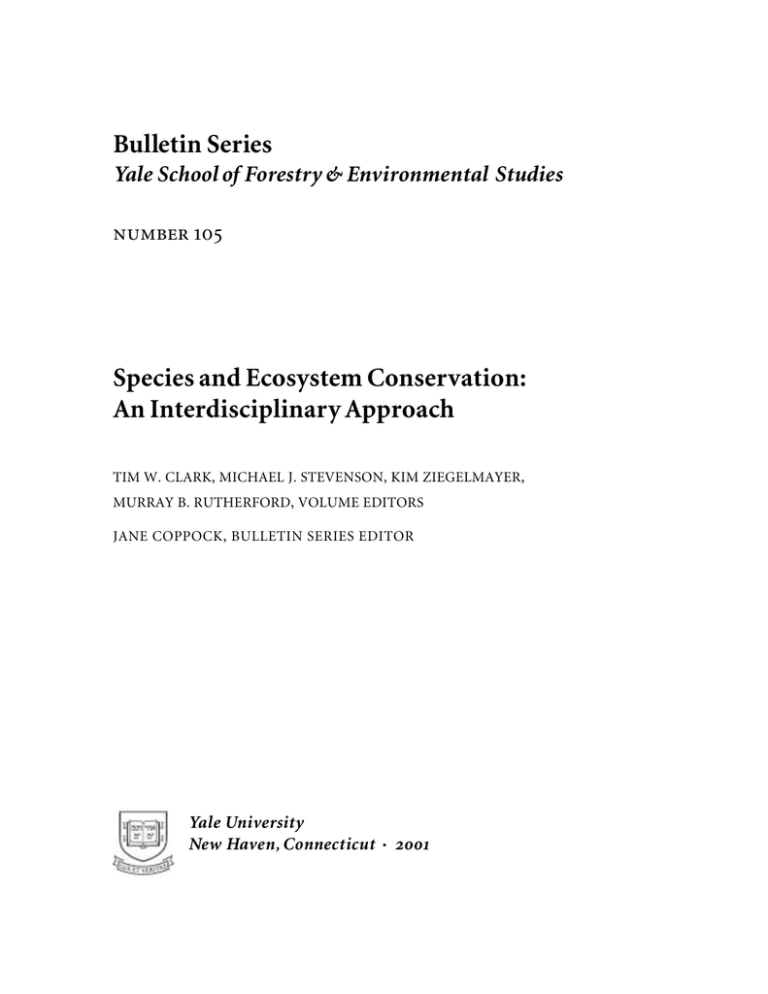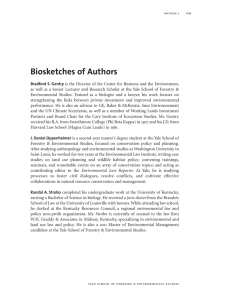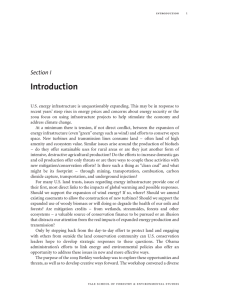Bulletin Series Species and Ecosystem Conservation: An Interdisciplinary Approach
advertisement

Bulletin Series Yale School of Forestry & Environmental Studies Species and Ecosystem Conservation: An Interdisciplinary Approach TIM W. CLARK, MICHAEL J. STEVENSON, KIM ZIEGELMAYER, MURRAY B. RUTHERFORD, VOLUME EDITORS JANE COPPOCK, BULLETIN SERIES EDITOR Yale University New Haven , Connecticut • 2001 This volume was published as a cooperative effort between the Yale School of Forestry & Environmental Studies and the Northern Rockies Conservation Cooperative of Jackson, Wyoming. The Yale School of Forestry & Environmental Studies Bulletin Series, begun in 1912, publishes student and faculty monographs, symposia, workshop proceedings, and other reports in cooperation with other organizations. The aim of the Series is to contribute to improved natural resource management and policy. To order copies, or download PDF versions of individual articles contact: http://www.yale.edu/environment/ publications or Yale School of Forestry & Environmental Studies Bulletin Series 205 Prospect Street New Haven, Connecticut 06511, USA or Northern Rockies Conservation Cooperative P. O. Box 2705 Jackson, Wyoming 83001 Volume Editors Tim W. Clark, Michael J. Stevenson, Kim Ziegelmayer, and Murray B. Rutherford Bulletin Series Editor Jane Coppock Bulletin Design R. Richard Solaski Production Peggy Sullivan, Sullivan Graphic Design Editorial Assistance Amy Hayden Printing Yale University Reprographics and Imaging Services (RIS) Cover Design Russell Shaddox, Yale RIS Paper Mohawk Vellum, Cream White, 60 lb. text, acid free, recycled Produced with support from the: Northern Rockies Conservation Cooperative Bulletin Number ISSN - CODEN BYSSDM © Yale University Permission is granted to reproduce this volume without prior written consent. The analyses in this volume are the sole opinions of the authors. Contents WELCOME TO READERS 0 ACKNOWLEDGMENTS 0 PREFACE 0 LEADERSHIP IN SPECIES AND ECOSYSTEM CONSERVATION Tim W. Clark, Michael J. Stevenson, Kim Ziegelmayer, and Murray B. Rutherford 0 PART I: INTERDISCIPLINARY PROBLEM SOLVING 0 A Course on Species and Ecosystem Conservation: An Interdisciplinary Approach Tim W. Clark 0 Interdisciplinary Problem Solving in Species and Ecosystem Conservation Tim W. Clark 0 PART II: INTERDISCIPLINARY PROBLEM SOLVING IN PRACTICE— STUDENT CASE STUDIES FROM 1999 0 Interdisciplinary Problem Solving at the Local, Regional, and Global Scales Bridge Over Troubled Waters: Faith-based Stewardship in Chesapeake Bay Tracy A. Scheffler (featured case) 0 0 The Canadian North Atlantic Cod Fishery: A Case Study of Management and Conservation Policy (abstract) Gregory C. Jones 0 IUCN/Species Survival Commission Action Plans: An Interdisciplinary Approach (abstract) Alexandra C. M. Baillie 0 Protected Areas Management: Integrating Communities, Conservation, and Development Galapagos Islands: Managing Introduced Species in an Endangered Ecosystem Michael J. Stevenson (featured case) 0 0 The Impact of Human Conflict on Eastern Lowland Gorilla Conservation in Kahuzi-Biega National Park, Democratic Republic of Congo (abstract) Omari O. Ilambu 00 Conflict Resolution Between Local Communities and Park Management in Lake Mburo National Park, Uganda: The African Wildlife Foundation’s Role (abstract) Chris M. Nyce 00 Tourism and Development: Implications for Snow Leopard Conservation in the Annapurna Conservation Area, Nepal (abstract) Kim Ziegelmayer 00 Species Conservation in the United States (W)helping the Wolves: A Perspective on De-listing Endangered Species in Minnesota Barry Ross Muchnick (featured case) Black Tailed Prairie Dogs: A New Era of Management? (abstract) Caroline G. Kuebler The Yellowstone Grizzly Bear Policy Process (abstract) Julie T. Stein Evaluating Conservation Initiatives Resolving Land Conflict Along the Border of the Mbaracayú Reserve, Paraguay Jonathan Padwe (featured case) 00 00 00 000 000 000 The Illegal Extraction of Mai hom, a Non-timber Forest Product, in Khao Yai National Park, Northeast Thailand (abstract) Christie M. Young 000 From Upper to Lower River: A Decision Process Analysis of the Housatonic River Restoration in New England (abstract) Kerry M. Cesareo 000 Recommendations for a Smooth Ecological and Social Transition into the Future for Agro-pastoralists of the Baringo Lowlands, Northern Kenya (abstract) Ashley G. Lanfer 000 PART III: INTERDISCIPLINARY PROBLEM SOLVING IN PRACTICE— STUDENT CASE STUDIES AND OTHER APPLICATIONS 1990-1998 000 Conserving Biodiversity in Hawai’i: What is the Policy Problem? Jonathan L. Scheuer and Tim W. Clark 000 Zoos and Conservation: Policy Making and Organizational Challenges Nicole A. Mazur and Tim W. Clark 000 The Policy Frontier: Sustainability Planning in Teton County, Wyoming Sue Lurie and Tim W. Clark 000 Organizing an Effective Partnership for the Yellowstone to Yukon Conservation Initiative Tim W. Clark and David L. Gaillard 000 Finding Common Ground in Biological Conservation: Beyond the Anthropocentric vs. Biocentric Controversy Alejandro Flores and Tim W. Clark 000 CONCLUSION: KNOWLEDGE AND SKILLS FOR PROFESSIONAL PRACTICE Tim W. Clark, Murray B. Rutherford, Kim Ziegelmayer, and Michael J. Stevenson 000 E-Mail: nrcc@wyoming.com Welcome to Readers This volume introduces and illustrates an interdisciplinary approach to species and ecosystem conservation. We know from our own diverse experience and that of many other professionals that this approach can improve policy and management in many contexts. Improving our problemsolving and leadership skills is one of the most important challenges of our time. The formal course summarized in this volume and the interdisciplinary approach it uses can be applied with good effect in many situations. The students who have used this approach in Tim Clark’s course at the School of Forestry & Environmental Studies over the past 11 years have found it helpful in analyzing and recommending conservation solutions in cases across Africa, South America, Asia, Australia, and North America. We hope you will find the information in this volume pertinent to your work as well. One of the primary roles of NRCC is to help citizens and governments manage natural resources in the best ways possible, and we feel that this volume will be helpful in that regard. NRCC typically carries out work in half a dozen countries at any one time. The organization also supports students, interns, and others in their efforts to become better problem solvers and leaders. This publication is a genuinely cooperative product of NRCC and the Yale School of Forestry & Environmental Studies. The editors were all affiliated with both organizations when they prepared this volume (with NRCC as board members, research associates, or interns, and with Yale as graduate students, doctoral candidates, or professors). Copies of this document can be ordered from the Yale School of Forestry & Environmental Studies at www.yale.edu/environment. We would appreciate your feedback. Sincerely, Louise Lasley Executive Director Northern Rockies Conservation Cooperative NRCC Board of Directors Tim W. Clark, President Lance Craighead, Vice-President Denise Casey, Secretary-Treasurer Louise Lasley, Executive Director Leonard Carlman George Gorman Peyton Griffin Catherine Patrick Acknowledgments Many people contributed information, time, and money to this volume. Their knowledge, generosity, and professionalism made this work possible, and we sincerely appreciate their many and varied contributions. Among these people were those interviewed in preparing the case studies described in Parts II and III. They live in diverse countries on several continents and in situations that range from small villages in tropical jungles to highly industrialized cities. Of course, this volume would not have been possible without the hard work of the authors of the featured cases and their classmates, and all of the students who have taken Tim Clark’s species and ecosystem conservation courses over the last 11 years. Yale University’s School of Forestry & Environmental Studies and the Northern Rockies Conservation Cooperative, Jackson, Wyoming, provided financial support. Support for the Northern Rockies Conservation Cooperative was generously provided by Gilman Ordway, Catherine Patrick, Hopie and Bob Stevens, the Wiancko Charitable Foundation, The New-Land Foundation, the Henry P. Kendall Foundation, and Stephen and Amy Unfried. Jane Coppock, editor of the Yale School of Forestry & Environmental Studies Bulletin Series, provided significant support. We would also like to thank the many people who critically reviewed the manuscripts. Preface This volume introduces a genuinely interdisciplinary problem-solving approach and applies it to cases ranging from the conservation of single species to ecosystem management, and to policy problems across local, regional, national, and international scales. Many people today are seeking to learn such an interdisciplinary approach and would like to develop the skills to use it successfully in diverse situations. The present volume is offered to help them in the dual task of learning and applying this approach. All papers in this volume emphasize cooperative, effective problem solving. The method of problem solving that is discussed and demonstrated here has been taught in the School of Forestry & Environmental Studies at Yale University for the last 11 years in a course called “Species and Ecosystem Conservation: An Interdisciplinary Approach.” The course teaches problem-solving skills and offers students an opportunity to apply them. Case applications cover the spectrum of contemporary conservation challenges. Each year the course has been diverse in terms of student backgrounds, disciplines represented, skills present, and lifetime experiences and interests. Over a decade’s experience shows that this interdisciplinary approach can be learned, talked about explicitly, and applied systematically, as the contents of this Bulletin illustrate. The Bulletin begins with a brief introduction to the species and ecosystem conservation challenge, the professional task, and the skills needed to address it successfully. The remainder of the volume is divided into three parts. Part I introduces the concept of interdisciplinary problem solving, and provides several lists of general questions to guide application. Within Part I, the first paper describes in detail the course “Species and Ecosystem Conservation: An Interdisciplinary Approach,” which is designed to teach and learn this approach to leadership and problem solving. The concluding paper in Part I discusses concepts and methods for successful problem solving, and uses an example of a species conservation challenge to illustrate the fundamental ideas. In Part II, selected cases from the 1999 class are used to illustrate this interdisciplinary approach and its successful “first time” application by university students. Four cases are featured: shellfish conservation in Chesapeake Bay, United States; introduced species management in the Galapagos Islands of Ecuador; wolf recovery in Minnesota in the United States; and land conflict along the border of the Mbaracayú Reserve in Paraguay. Ten other abstracts describing cases from a broad range of geographic locations, together with a listing of cases examined by the other students in the 1999 course, further illustrate the range of possible applications. In Part III, five additional cases from previous years are offered which use the interdisciplinary problem-solving approach in a flexible way, emphasizing the various aspects of problem solving. For example, a paper on biodiversity conservation in Hawaii focuses on “problem definition,” whereas an analysis of zoos examines policy direction and organizational flexibility. Part III also includes a list of other selected cases from those examined by the over 200 students who have taken this class over the last 11 years, again showing the broad range of possible applications. The final paper of the volume provides an overview of interdisciplinary problem solving and discusses how this approach might be utilized by a professional to address a specific conservation problem. The material in this Bulletin is directed toward a diverse audience throughout the world. It is intended for anyone interested in improving their own problem-solving skills, regardless of the situations in which they find themselves. It serves as a reader and casebook for students in future courses at Yale University, but it can also aid people who do not have the opportunity to take a course at Yale to learn about this approach. These papers are also available for downloading at the Yale School of Forestry & Environmental Studies website (www.yale.edu/environment/publications). In addition, it is a guide to further reading, as numerous citations and examples using the problem-solving method are included in the literature referenced in each paper. Our hope is that this volume will encourage both new and more experienced professionals everywhere to learn and apply interdisciplinary problem solving to the challenges of species and ecosystem conservation. The Editors









